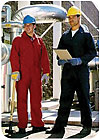
Manufacturing employees work hard, and so must the uniforms they wear. For a uniform to be of value it must be both comfortable and durable. In many cases that uniform must also offer a significantly higher level of protection from workplace hazards than ordinary street clothes.
In 2000, the National Fire Protection Association introduced changes to NFPA 70E, a voluntary standard to implement to increase worker safety that created risk categories for common electrical tasks. In turn, electric arc protective garments are required to be labeled with arc ratings so that the protection they provide can be matched to workplace hazards. Industry-wide familiarity with flame-resistant fabrics expanded even though some users felt the standard was cumbersome and often challenging to interpret. The standard covers workers in a variety of occupations, including maintenance personnel who install, maintain or repair electrical systems.
The 2004 revision of NFPA 70E attempted to overcome the limitations of the 2000 version and make it easier for the average worker in contact with electricity to understand the safety procedures and apparel requirements. Apparel and protective wear decisions can be addressed under the updated 2004 NFPA 70E using a table method with a task breakdown showing appropriate levels of protection, or by a calculation method based on prediction of energy levels that could be encountered by the worker.
Quantum leap
Similarly, flame-resistant fabrics available for uniform applications also are helping make life easier for industrial managers and their employees. Less constricting, easier to clean and offering increased safety, the uniforms of the 21st century are a quantum leap from what was available just a few years ago.Uniform service companies (those who rent, lease and sell uniforms) provide assistance to customers that goes beyond simply providing garments, picking up dirty uniforms, washing them and delivering clean ones. These companies also consult with clients and listen to their concerns to make sure they are choosing the uniform fabrics that best meet their objectives, offering performance-related information about the latest textile technologies for workwear.
The Uniform and Textile Service Association (UTSA) is an international trade organization that represents these companies and works to convey information about new uniform textile options.
FR advances
When considering flame-resistant fabrics for employee uniforms based on the 2004 NFPA 70E standard, keep in mind that flame-resistant fabric technology is evolving continually. Referencing the NFPA 70E table, when job tasks span voltage testing to operation of circuit brakers with panel covers off and up to 600 v., basic-level flame resistance in clothing at weights of 4.5 ounces to 5.5 ounces should be introduced. As exposure levels increase, higher weight flame-resistant fabrics and eventually coveralls or multilayer flash suits, face shields and other protective equipment are added to the NFPA table’s clothing column.Temperatures of an arc flash can reach upwards of 35,000 degrees Fahrenheit in less than a second, burning a person directly or causing ignition of non-flame-resistant clothing or the melting of clothing into the skin. While safety must be the top priority, worker comfort also is critical so that distractions are minimized and good morale is maintained. Workers, of course, need to be kept safe, but it’s also important that they not become too warm while wearing their FR garments.
Today’s flame-resistant fabrics address these needs by being more breathable and comfortable than those of the past, helping to motivate employees to want to wear their FR pants, shirts, coveralls and outerwear. Flame resistance often is not diminished by laundering, and some FR fabric technologies help prevent buildup of nuisance static electricity. Personnel grounding is required in hazardous static control situations.
Flame-resistant fabric alternatives currently include a flame-resistant finish that can be added to cotton blend fabrics, with the finish also increasing the fabric’s color retention and maintaining the much-loved comfort and breathability of cotton fabric.
Also of increasing interest to employers is heavyweight denim, which can be treated to meet flame-resistance standards. Denim is available in pre-washed lots for uniform production.
Other choices include blends of synthetic, inherently flame-resistant fibers designed to address specific needs that have been identified in the market.